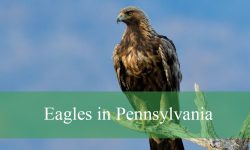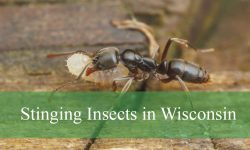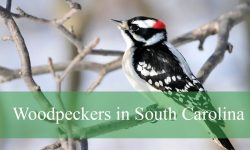Kentucky offers a rich and varied landscape that supports many species of black birds, from open farmlands to forested hills and winding rivers. These birds range from the familiar American Crow to the elusive Rusty Blackbird, each bringing its own voice and behavior to the state’s natural chorus.
Black birds in Kentucky can be found year-round, with some species flocking together in massive numbers during winter, while others appear briefly during spring or fall migration. Their dark plumage, shimmering iridescence, and fascinating habits make them stand out against every kind of backdrop, rural or urban.
This article highlights 13 black birds in Kentucky, featuring clear identification tips and vivid pictures. With a bit of observation and patience, these birds reveal their unique roles in local ecosystems and become a rewarding part of any birdwatching experience.
Common Black Birds Found in Kentucky
American Crow
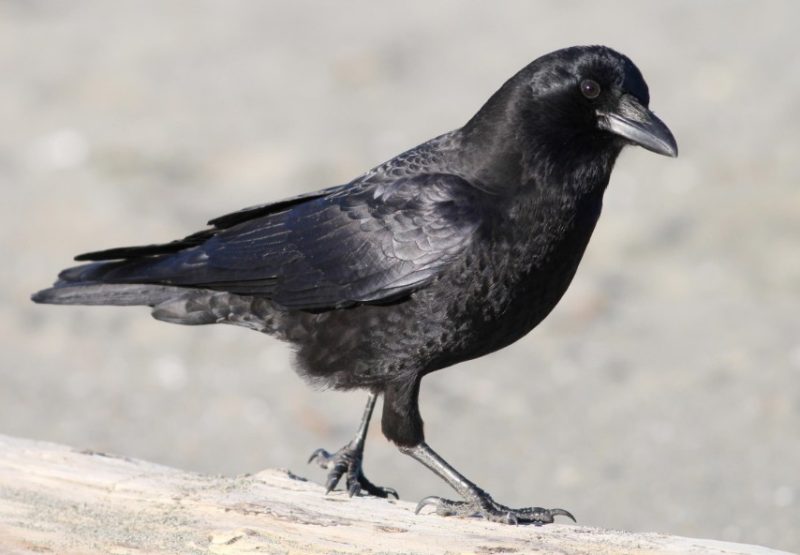
The American Crow (Corvus brachyrhynchos) is one of the most easily recognized black birds across North America. Medium to large in size, it measures between 16 to 21 inches in length with a wingspan of up to 39 inches. It has glossy black feathers from beak to tail, including black legs and feet, with a stout, slightly curved bill. In flight, it shows broad, rounded wings and a distinctive fan-shaped tail. Despite its dark appearance, its feathers can show hints of iridescent purple or blue in the sunlight.
Its vocalizations are among its most distinctive traits. The crow’s call is a harsh “caw caw,” repeated several times and often used to communicate with other members of its group. They are highly social and intelligent, using their calls to warn of predators, announce territory, or call others to food sources. Some American Crows even show the ability to mimic human speech, though not as clearly as ravens.
In Kentucky, American Crows are year-round residents and can be found in virtually every habitat type, from dense forests to open farmlands and urban areas. They are particularly common near fields, roadsides, landfills, and wooded neighborhoods. Their adaptability to human-altered environments has helped them thrive statewide. During winter, large communal roosts of crows are often seen in cities like Louisville and Lexington, where thousands gather nightly.
Crows are known for their remarkable intelligence. They can solve complex problems, use tools, and even recognize individual human faces. A fun fact is that crows hold “funerals” — when one dies, others gather and call loudly, possibly to assess threats. Their strong family bonds, cooperative breeding, and complex social behaviors make them one of the most fascinating birds in Kentucky.
Fish Crow
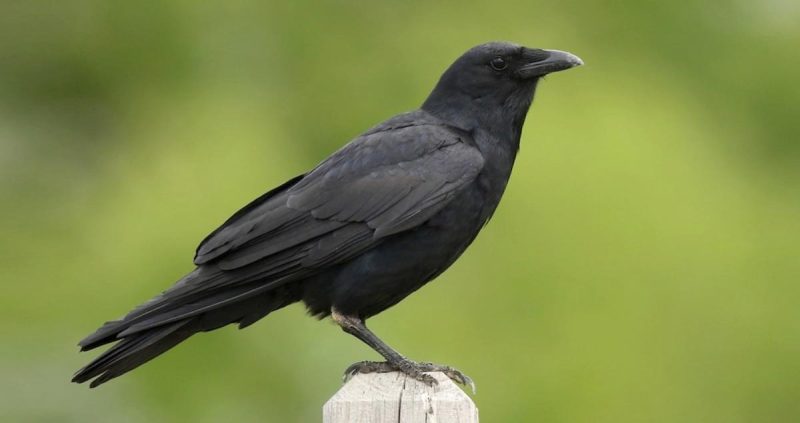
The Fish Crow (Corvus ossifragus) is a smaller cousin of the American Crow and closely resembles it in appearance, making identification tricky without hearing its call. It measures about 14 to 16 inches in length with a wingspan around 33 inches. Like the American Crow, it is entirely black, including eyes, beak, and legs, but it tends to have a slightly slimmer build and shorter wings and tail. The plumage has a subtle glossy sheen that may show bluish or purplish hues in sunlight.
The easiest way to distinguish a Fish Crow is by its voice. Instead of the familiar “caw” of the American Crow, the Fish Crow makes a nasal “uh-uh” sound, often described as sounding sick or whiny. These two-syllable calls are most frequently heard during the breeding season and are key to separating the two species, especially in overlapping territories.
In Kentucky, the Fish Crow is primarily found in the western and central parts of the state, especially near major rivers, wetlands, and reservoirs. It is most common along the Ohio and Mississippi Rivers and in wetland areas like Ballard Wildlife Management Area. Although historically limited to coastal and lowland regions, this species has been gradually expanding inland, including deeper into Kentucky.
Despite its name, the Fish Crow does not eat only fish. It’s an opportunistic feeder, consuming anything from small aquatic animals to carrion, garbage, and even bird eggs. Like other crows, it is highly intelligent and capable of problem-solving. A fun fact about Fish Crows is that they often nest in loose colonies and have been observed stealing food from other birds and even other crows.
Common Raven
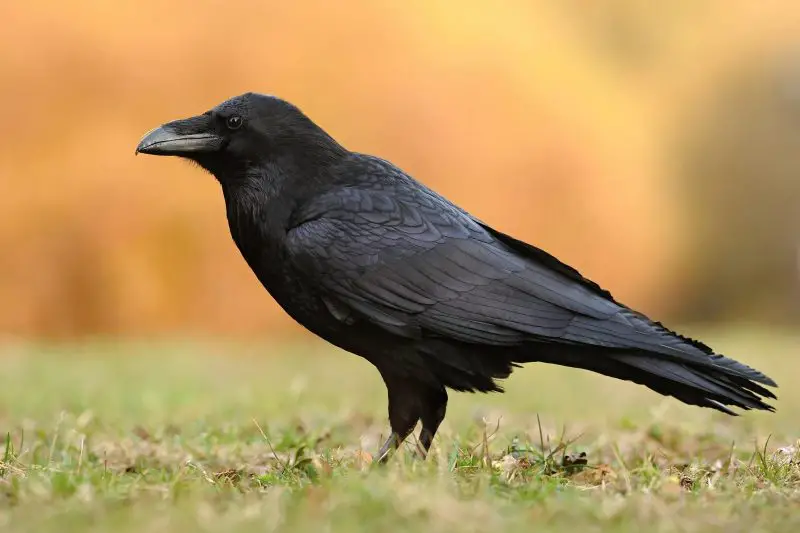
The Common Raven (Corvus corax) is the largest member of the corvid family and among the most intelligent birds in the world. Significantly larger than both the American and Fish Crow, it measures 22 to 27 inches in length and has a wingspan that can exceed 50 inches. Its shaggy throat feathers (called hackles), heavy bill, and wedge-shaped tail are useful identification features. Its plumage is deep black with a noticeable blue or purple gloss in direct light.
Unlike the simple calls of crows, the Common Raven produces a wide variety of sounds. Its most common vocalization is a deep, resonant “croak,” but it also makes knocks, whistles, clicks, and gurgling sounds. Some ravens can mimic sounds they hear in their environment, including human voices and mechanical noises. Their complex vocal abilities reflect their high intelligence and strong social structure.
In Kentucky, ravens are extremely rare and primarily restricted to the Appalachian region in the far southeast. Sightings have occasionally been recorded in mountainous areas such as the Cumberland Plateau. Their rarity in the state makes any encounter with one a special experience for birdwatchers. They prefer remote, rugged terrain with cliffs and large trees, far from human development.
Common Ravens are known for their problem-solving skills, playfulness, and even tool use. They often soar in the sky like hawks, performing aerial acrobatics for apparent enjoyment. A fun fact is that ravens have been observed sliding down snow-covered roofs and playing games with sticks. Their intelligence is comparable to that of dolphins and chimpanzees, placing them among the smartest animals on Earth.
Red-winged Blackbird
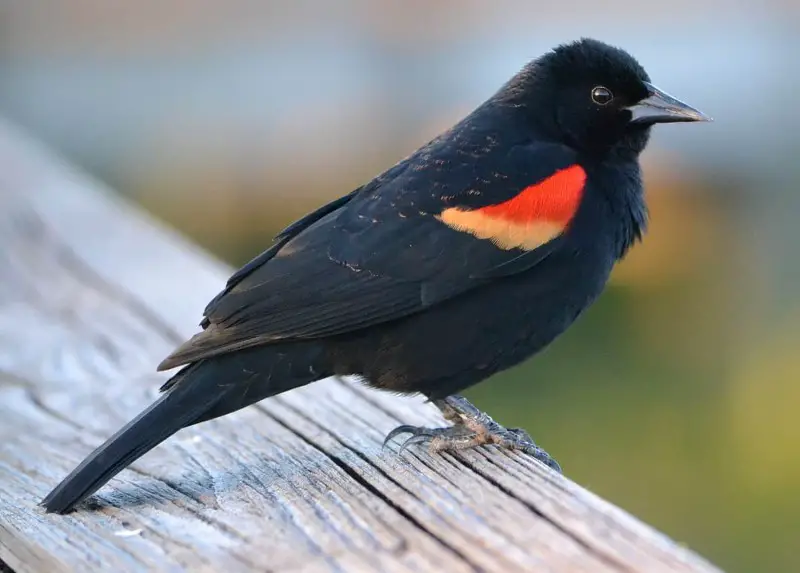
The Red-winged Blackbird (Agelaius phoeniceus) is one of the most widespread and recognizable blackbirds in North America. The adult male is jet black with striking red and yellow shoulder patches called epaulets. Females, in contrast, are heavily streaked brown and look more like large sparrows, which often leads to confusion. These birds measure 7 to 9 inches long with a wingspan of up to 15 inches.
Their vocalization is one of the most familiar springtime sounds: a conk-la-reeee call that rings out from marshes, fields, and wetland edges. Males sing frequently and from prominent perches to defend their territories and attract females. Their calls are especially prevalent at dawn and dusk during the breeding season and often accompanied by wing spreading to flash their red epaulets.
In Kentucky, Red-winged Blackbirds are abundant throughout the year, though numbers increase significantly in spring and summer with the arrival of migratory birds. They are most commonly found around wetlands, lakeshores, ponds, and wet fields. They breed prolifically in cattail marshes and are also seen in agricultural fields, where they may nest in hay or grain crops.
These birds are known for their aggressive behavior during nesting season. Males will fiercely defend their nesting territory, often attacking much larger animals, including humans. A fun fact is that one male may mate with multiple females within his territory, leading to highly competitive displays and vocal duels in spring. Their large communal roosts in winter can include thousands of individuals, sometimes mixed with grackles and starlings.
Common Grackle
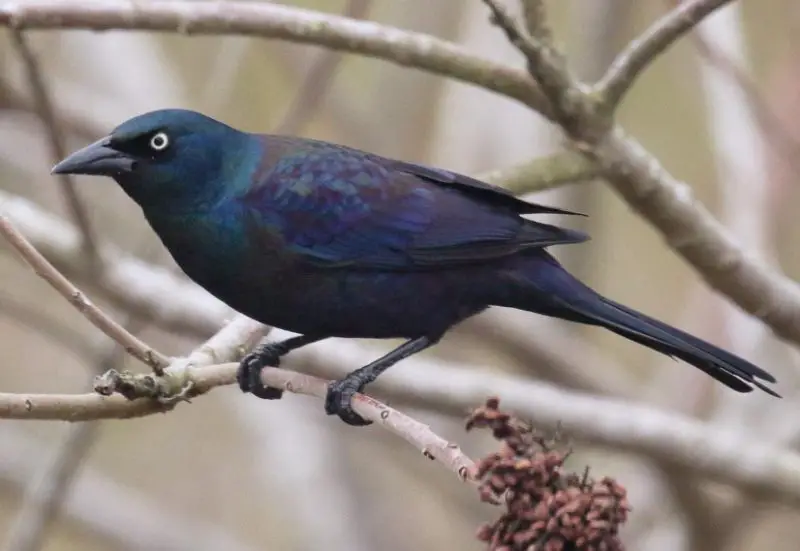
The Common Grackle (Quiscalus quiscula) is a large, sleek blackbird with a long, keel-shaped tail and a sharp, pointed bill. It measures 11 to 13 inches in length with a wingspan of about 17 inches. Males are glossy black with iridescent hues of purple, green, and blue on their head and body, while females are slightly smaller and duller. Both sexes have piercing yellow eyes, which give them a striking appearance.
Their call is a harsh, creaking “readle-eak” or “chack,” often described as sounding like a rusty gate. Grackles are noisy birds that frequently call in groups, particularly at dawn and dusk. During the breeding season, males will sing while puffing up their feathers, raising their wings, and pointing their bills skyward to attract mates and defend territory.
In Kentucky, Common Grackles are widespread and commonly found in open woodlands, farmland, suburban areas, and wetland edges. They are especially abundant in agricultural regions where they forage in large flocks. These birds are present year-round in the state, although populations may shift somewhat with seasonal migrations.
Grackles are known for their opportunistic and often mischievous feeding habits. They eat everything from insects and seeds to garbage and even other birds’ nestlings. A fun fact is that they are capable of cracking open acorns and other nuts with their strong bills, and they have been seen dunking dry food in water to soften it. Their shimmering plumage and gregarious nature make them a visually and behaviorally captivating species in Kentucky’s birdlife.
Brewer’s Blackbird
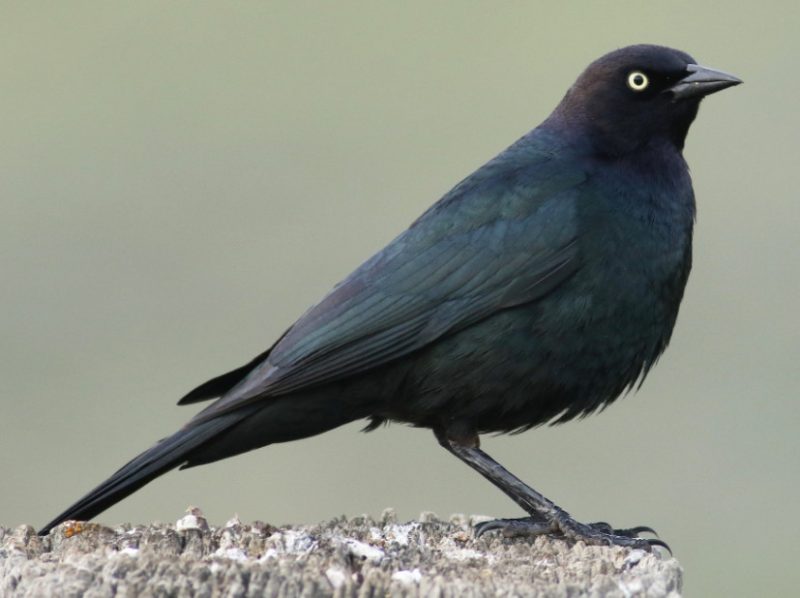
The Brewer’s Blackbird (Euphagus cyanocephalus) is a medium-sized, sleek blackbird with a more subtle appearance than some of its flashier relatives. Males are glossy black with a bluish or purplish sheen on the head and a greenish iridescence on the body. Females are more muted, appearing brownish-gray overall with dark eyes and a slender bill. This sexual dimorphism makes the species relatively easy to identify once both sexes are known. Adults measure about 8 to 10 inches in length and have a wingspan of 14 to 15 inches.
Their calls are a mix of high-pitched whistles and harsh, squeaky notes. The male’s song includes a rough “kree” or “tschup” sound followed by a thin wheeze. They are often heard in open areas as part of small to medium-sized flocks. Brewer’s Blackbirds are not as musical or varied as the Red-winged Blackbird, but their song serves an important role in territory defense and mate attraction.
In Kentucky, Brewer’s Blackbirds are mostly seen during migration and in winter, particularly in the western and central parts of the state. They are not widespread breeders in the state but may occasionally nest in rural areas near farms or grasslands. During colder months, they often forage in flocks alongside other blackbirds such as Common Grackles and Red-winged Blackbirds, especially in agricultural fields and pastures.
Brewer’s Blackbirds are extremely adaptable and will take advantage of urban parks, parking lots, and roadside areas where food is abundant. They eat seeds, grains, and insects, often walking or running rather than hopping like some other songbirds. A fun fact is that this species is named after the American ornithologist Thomas Mayo Brewer, and it has expanded its range eastward over the past century, possibly due to land use changes and agriculture.
European Starling
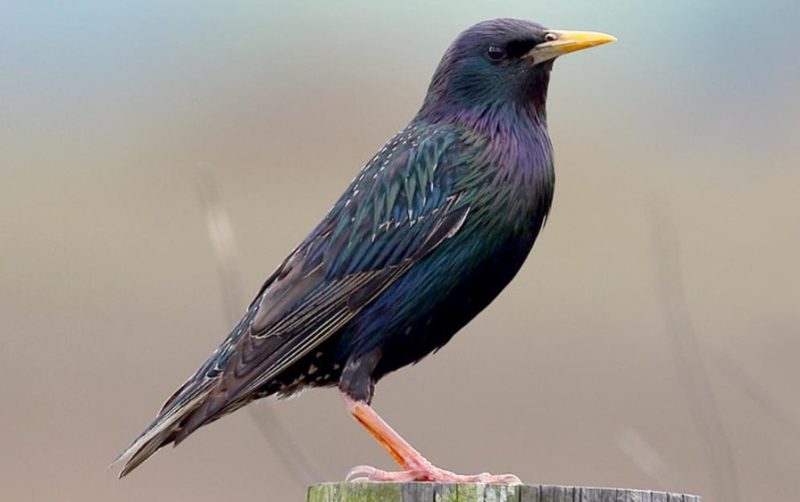
The European Starling (Sturnus vulgaris) is an introduced species that has become one of the most common and widespread birds in North America. Adults are about 8.5 inches long with a wingspan of roughly 16 inches. In breeding season, they appear glossy black with an iridescent sheen of purple and green, and they sport a bright yellow bill. In fall and winter, their feathers develop pale tips, giving them a speckled or “starry” look — the origin of their name.
Starlings are highly vocal birds with a complex range of whistles, clicks, squeals, and mimicry. They are skilled mimics and can imitate other birds, mechanical noises, and even human speech. Their song is a mixture of squeaky, chattery notes often delivered from a rooftop or high perch. In large flocks, their constant noise is easily recognizable and contributes to their conspicuous presence.
European Starlings are present throughout Kentucky year-round and are commonly seen in both rural and urban environments. They nest in cavities, including tree holes, vents, and man-made structures. Their adaptability has made them dominant in cities, farmland, and open woodlands alike. They frequently form massive winter flocks known as murmurations, which create swirling, synchronized shapes in the sky — an incredible sight across the state.
Despite their beauty in flight, starlings are considered invasive in the United States. They were introduced to North America in the 1890s by a group in New York who wanted to bring all birds mentioned in Shakespeare’s works to the continent. A fun fact: today’s starlings descend from just 100 individuals released in Central Park. They’ve since grown into a population of over 200 million birds, often outcompeting native species for nesting sites and food.
Black Vulture
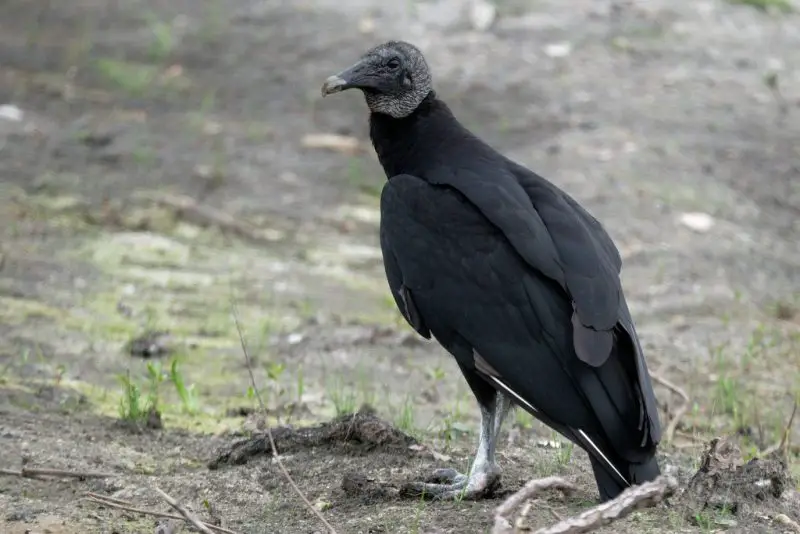
The Black Vulture (Coragyps atratus) is a large, broad-winged bird that plays a crucial role in Kentucky’s ecosystem as a scavenger. It has a stocky body, short tail, and sooty black feathers all over its body. The head and neck are featherless and appear grayish-black and wrinkled, giving the bird a prehistoric look. Adults measure about 22 to 27 inches long with a wingspan of up to 5 feet (around 60 inches), though they are generally smaller than Turkey Vultures.
Unlike many songbirds or corvids, Black Vultures are mostly silent due to a lack of a syrinx (voice box). They communicate through hisses and grunts, particularly when feeding or defending a carcass. They can sometimes be heard making soft raspy sounds, but their presence is typically detected visually rather than audibly. Their silence adds to the eerie, ghost-like feeling they bring when soaring in groups.
In Kentucky, Black Vultures are common year-round, especially in the central and southern parts of the state. They are often seen soaring high in the sky, using thermal currents to glide effortlessly with their wings held flat and their wingtips splayed. In flight, they can be distinguished from Turkey Vultures by their shorter tails and the silvery patches at the tips of their wings. They are commonly spotted near highways, landfills, and open rural areas.
Black Vultures rely on their eyesight to find food and often follow Turkey Vultures to locate carrion, as the latter has a more developed sense of smell. A fun fact is that Black Vultures are more aggressive than their red-headed cousins and will sometimes chase other scavengers away from a carcass. Though often misunderstood, they provide an essential service by cleaning up dead animals and preventing the spread of disease. They also form strong family bonds, with some young staying with their parents for extended periods.
Rusty Blackbird
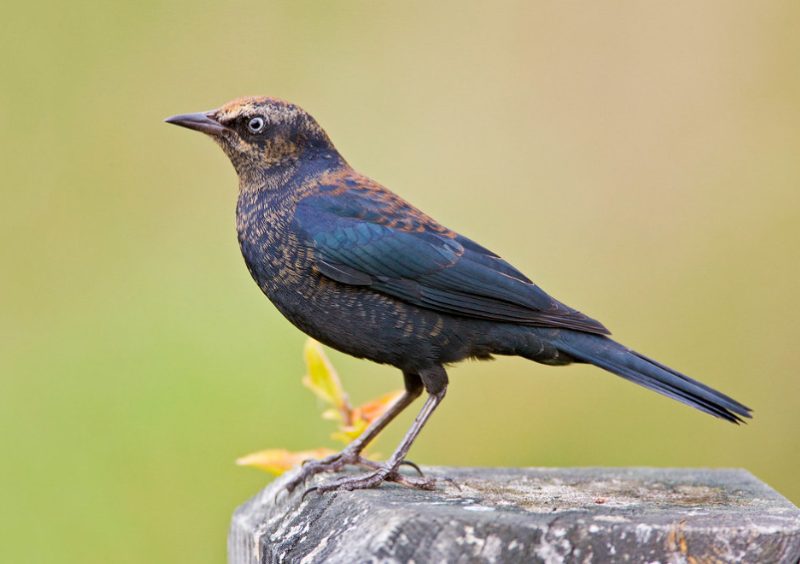
The Rusty Blackbird (Euphagus carolinus) is a medium-sized, slender blackbird that undergoes noticeable seasonal changes in plumage. During winter, males appear dark with a rusty-brown wash over their body and edges of feathers, while females are a lighter gray-brown with similar rusty tones. In breeding season, males turn glossy black with a greenish sheen, while females become dark gray. Their pale yellow eyes stand out against their darker feathers. They measure around 9 inches in length and have a wingspan of about 14 inches.
Rusty Blackbirds produce high-pitched, creaky whistles and squeaky calls, often described as “gurgling” or “rusty-hinge” sounds. Their vocalizations are most often heard during spring migration or while feeding in flocks in quiet, swampy areas. Males sing from low perches or treetops, but their songs are less musical and more mechanical compared to other blackbirds.
In Kentucky, Rusty Blackbirds are primarily seen during migration, especially in spring and fall. They favor flooded forests, wooded swamps, wet pastures, and the edges of ponds and streams. Western Kentucky, with its bottomland forests and wetland habitats, provides good stopover points during their migration. They are less common in urban or dry upland areas and are often overlooked due to their secretive nature and resemblance to other blackbirds.
This species is one of the fastest-declining songbirds in North America, having lost over 85% of its population in recent decades. A fun fact: unlike most blackbirds, Rusty Blackbirds often forage in shallow water, flipping leaves and probing for aquatic insects and snails. Their rusty winter coat gives them a uniquely seasonal appearance that helps with identification during migration in Kentucky.
Brown-headed Cowbird

The Brown-headed Cowbird (Molothrus ater) is a small blackbird known for its unusual and parasitic breeding behavior. Adult males have a glossy black body with a distinct chocolate-brown head and a short, conical bill. Females are smaller and dull brown overall with faint streaking and dark eyes. Cowbirds measure about 7.5 inches in length and have a wingspan of 12 to 14 inches, making them relatively compact among blackbirds.
Males produce a bubbly, liquid-sounding song that resembles a series of gurgles and whistles. Their vocalizations are accompanied by a bowing display and wing spreading to attract females. The call is distinctive once learned and can be heard in fields, grasslands, and woodland edges throughout the breeding season.
Brown-headed Cowbirds are found across Kentucky from spring through fall, with many overwintering in the southern parts of the state. They are particularly common in open areas near woods, pastures, and suburban lawns. Cowbirds do not build their own nests; instead, females lay their eggs in the nests of other bird species, often at the expense of the host’s offspring. Over 200 species of birds are known to have been parasitized by cowbirds.
A fascinating fact about cowbirds is that they evolved to be nest parasites because of their historical association with nomadic bison herds, which kept them constantly on the move. Because they could not stay in one place long enough to raise their young, they left the parenting to other birds. While interesting from an evolutionary perspective, their parasitism has contributed to the decline of several sensitive host species, such as the Wood Thrush and Kentucky Warbler.
Yellow-headed Blackbird
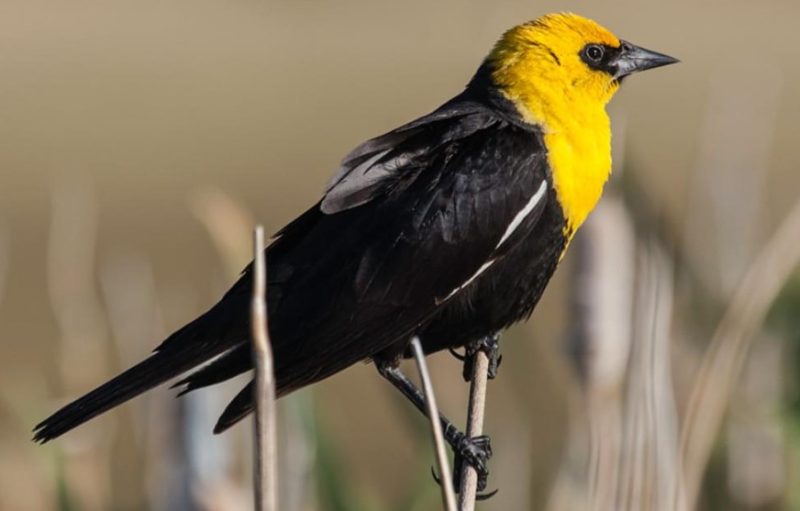
The Yellow-headed Blackbird (Xanthocephalus xanthocephalus) is one of the most striking blackbirds in North America. Males are bold and unmistakable, with a bright yellow head and chest contrasting sharply with a black body, wings, and tail. They also have white wing patches that flash in flight. Females are mostly dull brown with a faint yellowish wash on the face and breast. These birds measure about 9 to 10 inches long with a wingspan of up to 17 inches.
Their song is loud and raspy, often described as a harsh, mechanical series of “scronk” notes that sound more like a rusty gate than a melodious tune. While the sound is not considered beautiful, it’s quite distinctive and often heard coming from marshes in spring and summer. Males often sing from tall reeds or cattails to proclaim their territory.
In Kentucky, Yellow-headed Blackbirds are uncommon and typically seen only during migration, especially in the western half of the state. Some individuals may stop over in wetlands, agricultural fields, or marshes during their spring or fall journeys. They are far more common in the western United States but occasionally appear in mixed flocks of blackbirds and grackles in Kentucky’s wet fields.
These birds are highly social outside the breeding season and often form large flocks. A fun fact: Yellow-headed Blackbirds nest in colonies over water, usually attaching their nests to emergent vegetation like cattails. Males may defend small harems of females, similar to Red-winged Blackbirds, and will aggressively chase intruders. Their bold coloration and striking voice make them a memorable rare visitor to Kentucky.
Double-crested Cormorant

The Double-crested Cormorant (Nannopterum auritum) is a large, dark waterbird known for its long neck, slender body, and hooked bill. It measures about 29 to 36 inches in length and has a wingspan between 45 and 48 inches. Adults are entirely blackish with a subtle greenish or bronze sheen. During breeding season, they develop short, curly crests on each side of the head — hence the name “double-crested.” Their turquoise-blue eyes are especially striking up close.
Unlike songbirds, cormorants are not very vocal, but they do make low grunting or croaking sounds, especially around nesting colonies. When perched or drying their wings, they are often silent, but their guttural calls can be heard when they gather in groups on islands or treetops. Their flight is swift and direct, often in V-shaped flocks or long lines.
In Kentucky, Double-crested Cormorants are most commonly seen around large lakes, reservoirs, and major rivers. They are frequently spotted at Kentucky Lake, Lake Barkley, and along the Ohio River. Though some may overwinter in southern Kentucky, most are migrants passing through in spring and fall. They fish by diving underwater using their strong legs and sharp bills to catch fish and aquatic prey.
A fun fact about cormorants is that their feathers are not fully waterproof, which is why they are often seen standing with wings spread out to dry. This allows them to dive deeper but means they must sunbathe to stay warm. Though not traditionally considered elegant birds, they are skilled hunters and increasingly common throughout Kentucky’s waterways.
Black Phoebe
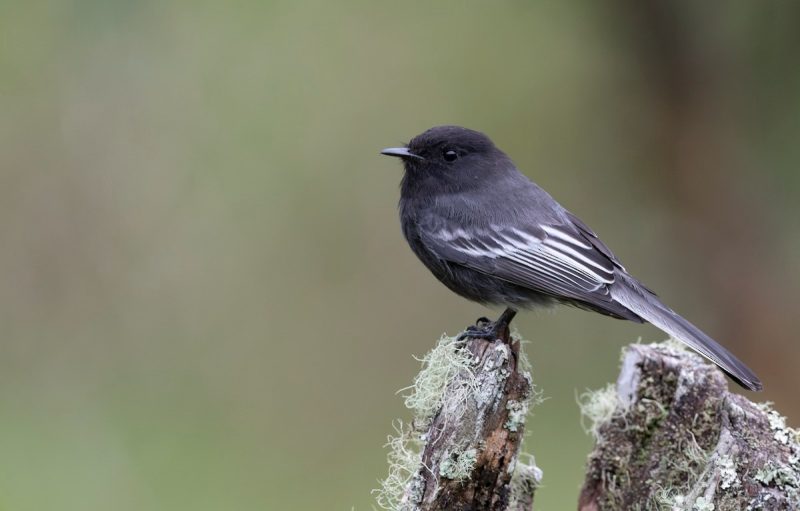
The Black Phoebe (Sayornis nigricans) is a small flycatcher with sharp black-and-white contrast and a clean, sleek profile. It has a sooty black head, chest, and upperparts, with a bright white belly and undertail. Its thin black bill and dark eyes contribute to its compact, alert appearance. Measuring only about 6.5 inches in length with a wingspan of 10.5 inches, it’s one of the smallest black birds you might see in Kentucky — though sightings are rare.
The vocalizations of the Black Phoebe include a sharp, high-pitched “tsip” or “chip,” repeated in rhythmic patterns. Its song consists of clear whistled phrases, often delivered from a perch near water. While not loud or musical, its repetitive call is easy to identify once you’ve heard it a few times.
In Kentucky, the Black Phoebe is an accidental or very rare visitor. Most of its native range is in the southwestern United States, Mexico, and parts of California. However, a few scattered records of vagrants have occurred in the southeastern U.S., including isolated sightings in Kentucky, usually near water bodies or in sheltered valleys.
Black Phoebes are strongly tied to water and often nest under bridges, overhangs, or cliff ledges near streams and ponds. They are flycatchers, using a technique called “sallying” — launching from a perch to catch flying insects and returning quickly. A fun fact is that they often bob their tails while perched, a behavior known as “tail dipping,” which helps distinguish them from similar-looking birds. If spotted in Kentucky, this small and elegant flycatcher is a rare delight for birders.
Best Time and Places to See Black Birds in Kentucky
Black birds are a diverse and fascinating group in Kentucky, ranging from intelligent crows and ravens to shimmering grackles, vibrant red-winged blackbirds, and unique seasonal visitors like the Rusty Blackbird. The best time to observe most of these species is during the spring and fall migration periods, typically from March to May and again from September to November. During these months, bird activity increases significantly, and many species travel through the state in large flocks, making them easier to spot in open fields, wetlands, and along river corridors. Summer is ideal for breeding species like Red-winged Blackbirds and Common Grackles, while winter brings large flocks of mixed blackbirds, including some rare visitors like Brewer’s or Rusty Blackbirds.
For the best birding locations, Kentucky offers a variety of habitats that support black bird diversity. Wetlands and marshes such as the Ballard Wildlife Management Area in western Kentucky or the Sloughs Wildlife Management Area near Henderson are hotspots for Red-winged Blackbirds, grackles, and sometimes Yellow-headed Blackbirds during migration. Large reservoirs and rivers, including Kentucky Lake, Lake Barkley, and the Ohio River, are excellent for viewing Double-crested Cormorants, Fish Crows, and Black Vultures. Meanwhile, urban parks and farmland throughout central and northern Kentucky are prime territories for American Crows, Common Grackles, and European Starlings year-round.
For those seeking rarer species, the Appalachian region in southeastern Kentucky is the most likely place to spot a Common Raven, especially near forested ridges and rocky outcrops. During late fall and early winter, birders should visit flooded forests and bottomlands, such as those near the Clarks River or Green River, to look for Rusty Blackbirds, a declining species that quietly forages in the shadows of leaf litter and shallow waters. Large blackbird roosts, sometimes numbering in the thousands, can also be found near agricultural fields at dusk in late fall and winter—providing an unforgettable wildlife spectacle.
Planning birdwatching trips during early morning hours yields the best results, especially from sunrise to mid-morning when birds are most active and vocal. Bringing binoculars, a field guide, or using a birding app like Merlin or eBird can help with identification, especially in mixed-species flocks. Whether you’re in a rural wetland or your backyard in Louisville, Kentucky offers rich opportunities year-round to observe the unique beauty and behavior of black birds in their natural habitats.




